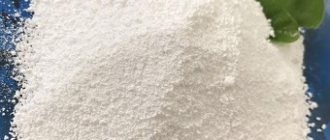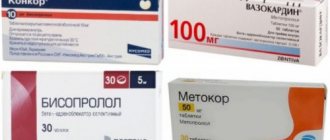Magnesium sulfate as a laxative
For 1 glass of boiled water you need to take 15-30 g of powder, stir everything and drink. To enhance the laxative effect, you need to consume as much warm liquid as possible. In this case, you will be able to notice the result within 30-40 minutes.
In no case should you take magnesium sulfate for several days in a row, otherwise you can damage the gastric mucosa, which can lead to serious consequences. For acute constipation, the product is used once. To empty the bowel, it is sometimes used together with anthelmintic drugs. For chronic constipation, enemas are done using a solution. To do this, you need to take 25 g of powder and dilute it in half a glass of water.
Magnesia - effect on the body
Magnesium sulfate, or Magnesia, is a mineral salt, a preparation based on magnesium salt of sulfuric acid. The medicine has another name - Epsom salts, it is available in different forms. The drug in ampoules or vials is intended for intravenous administration or placement of droppers; it is used intramuscularly much less frequently. Price - 20-70 rubles depending on the manufacturer. Contains per 1 ml:
- magnesium sulfate heptahydrate - 250 mg (25% solution);
- sodium hydroxide;
- water.
Magnesia is also sold in pharmacies in powders, which is used after dilution with water as a laxative. Using powders, you can make dubage to cleanse the gallbladder and intestines. The price of powders is 25-150 rubles.
Magnesia for injections is a powerful vasodilator.
When administered parenterally, the drug has a variety of beneficial effects. It relaxes the smooth muscles of the uterus, so it is often prescribed for increased tone in the early stages of pregnancy. Other effects of the drug:
- antihypertensive;
- antispasmodic;
- antiarrhythmic;
- anticonvulsant;
- choleretic;
- vasodilator;
- pain reliever;
- calming.
Magnesium injections help regulate metabolism in the body and reduce nervous excitability. Due to the relaxation of blood vessels, high blood pressure decreases, while urine output (diuresis) increases. The antiarrhythmic effect is achieved by reducing the excitability of cardiomyocytes and optimizing ionic balance.
WE RECOMMEND THE ARTICLE!
Magne B6, Magnelis, Magnerot, Asparkam and Magnesium Diasporal replenish magnesium deficiency in the body. Read more >>
The use of the drug in large doses is not permissible - it suppresses the respiratory center and inhibits neuromuscular transmission. Magnesia also acts as a calcium antagonist, displacing it from binding zones. If you take Magnesia in powder or inject it, it will serve as an antidote during heavy metal poisoning.
Contraindications
You should avoid taking magnesium sulfate if:
- bleeding in the rectum;
- dehydration of the body;
- intestinal obstruction;
- inflammation of appendicitis.
Should be taken under medical supervision if:
- inflammation of the gastrointestinal tract;
- respiratory problems;
- renal failure.
Description of the drug MAGNESIUM SULPHATE (MAGNESII SULFAS)
When taken orally, it has a choleretic (reflex effect on the receptors of the duodenal mucosa) and a laxative effect (due to poor absorption of the drug in the intestine, high osmotic pressure is created in it, water accumulates in the intestine, the intestinal contents are liquefied, and peristalsis is enhanced). It is an antidote for poisoning with heavy metal salts. The onset of the effect is after 0.5-3 hours, duration is 4-6 hours.
When administered parenterally, it has a hypotensive, sedative and anticonvulsant effect, as well as a diuretic, arteriodilatating, antiarrhythmic, vasodilating (on arteries) effect, in high doses - curare-like (inhibitory effect on neuromuscular transmission), tocolytic, hypnotic and narcotic effects, suppresses respiratory center. Magnesium is a physiological blocker of slow calcium channels and is able to displace it from binding sites. Regulates metabolic processes, interneuronal transmission and muscle excitability, prevents the entry of calcium through the presynaptic membrane, reduces the amount of acetylcholine in the peripheral nervous system and the central nervous system. Relaxes smooth muscles, reduces blood pressure (mostly elevated), increases diuresis.
The mechanism of anticonvulsant action is associated with a decrease in the release of acetylcholine from neuromuscular synapses, while magnesium suppresses neuromuscular transmission and has a direct inhibitory effect on the central nervous system.
The antiarrhythmic effect of magnesium is due to a decrease in the excitability of cardiomyocytes, restoration of ionic balance, stabilization of cell membranes, disruption of sodium current, slow incoming calcium current and one-way potassium current. The cardioprotective effect is due to the expansion of the coronary arteries, a decrease in peripheral vascular resistance and platelet aggregation.
The tocolytic effect develops as a result of inhibition of myometrial contractility (decreased absorption, binding and distribution of calcium in smooth muscle cells) under the influence of magnesium ion, increased blood flow in the uterus as a result of dilation of its vessels. Magnesium is an antidote for poisoning with heavy metal salts.
Systemic effects develop almost immediately after intravenous administration and 1 hour after intramuscular administration. Duration of action with intravenous administration is 30 minutes, with intramuscular administration - 3-4 hours.
How to take Magnesium Sulfate for weight loss
Before dieting, it is necessary to cleanse the intestines. Magnesium sulfate in this case is intended for one-time use. This method should not be used frequently, since the active substance irritates the gastric mucosa and can ultimately cause dysbacteriosis.
Those who want to lose weight need to add 200 g of powder to the bath. This bath should be taken for 20 minutes before bedtime. The course contains no more than 15 such procedures. It should be done no more than twice a week. The effect is achieved as follows: unnecessary fluid leaves the body, swelling disappears, and metabolic processes improve.
Indications of the drug
The medicine is widely used in gynecology and obstetrics, neurology, and gastroenterology. Droppers with magnesium sulfate are recommended for pregnant women both in the first trimester to prevent miscarriage, and in later stages. In the latter case, the indication is the threat of premature birth, increased uterine tone, preeclampsia, eclampsia, and high blood pressure.
For children, Magnesia is often prescribed as a solution for electrophoresis on the collar area - to improve venous outflow.
The drug is in great demand among neurological patients. Thanks to the relaxation of blood vessels, eliminating their hypertonicity and removing excess fluid from tissues.
Indications for the use of Magnesia intravenously are as follows:
- epilepsy and other types of seizures;
- encephalopathy of various origins;
- cerebral edema;
- hydrocephalus;
- in children - hyperactivity, cerebral palsy;
- nervous overexcitability.
Magnesium is dripped for various types of ventricular arrhythmias, especially those associated with potassium and magnesium deficiency. Gastroenterologists recommend the medicine for pathologies of the gallbladder - inflection, dyskinesia, chronic cholecystitis. For bronchial asthma, the medicine may also be indicated to stop bronchospasms. Among other things, indications for the use of Magnesia in injections are associated with urinary retention, edema, mercury and lead poisoning. A dropper or injections are given to patients with a hypertensive crisis. At home, people often take baths with Magnesia for weight loss.
Buy Magnesium sulfate powder for oral solution 25g in pharmacies
Instructions for use of Magnesium sulfate. size 25g
Dosage forms powder 25g Synonyms No synonyms. Group Peripheral vasodilators International nonproprietary name Magnesium sulfate Composition Active ingredient - magnesium sulfate. Manufacturers Vologda Pharmaceutical Factory (Russia), Krasnodar Pharmaceutical Factory (Russia), Tula Pharmaceutical Factory (Russia), Pharmaceutical Factory St. Petersburg (Russia), Chemical Plant named after. L.Ya. Karpova packaged Pharmaceutical factory of St. Petersburg (Russia) Pharmacological action Sedative, hypnotic, general anesthetic, anticonvulsant, antiarrhythmic, hypotensive, antispasmodic, laxative, choleretic, tocolytic. Magnesium is a physiological antagonist of calcium and is able to displace it from binding sites. Regulates metabolic processes, neurochemical transmission and muscle excitability, prevents the entry of calcium ions through the presynaptic membrane, reduces the amount of acetylcholine in the peripheral nervous system and the central nervous system. Relaxes smooth muscles, reduces blood pressure (mostly elevated). When administered by injection, it blocks neuromuscular transmission and prevents the development of seizures; in large doses it has curare-like properties. When taken orally, it is poorly absorbed (no more than 20%), increases osmotic pressure in the gastrointestinal tract, causes fluid retention and its release (along a concentration gradient) into the intestinal lumen, increasing peristalsis throughout its entire length, leading to defecation (after 4-6 hours) . Promotes the release of cholecystokinin, irritates the receptors of the duodenum, and has a choleretic effect. The absorbed portion is excreted in the urine, and diuresis increases; the rate of renal excretion is proportional to the plasma concentration. Systemic effects develop 1 hour after IM administration and almost immediately after IV administration. Their duration with intravenous administration is 30 minutes, with intramuscular administration - 3-4 hours. Passes through the BBB and placenta, creating concentrations in milk that are 2 times higher than concentrations in plasma. Side effects When administered by injection: bradycardia, conduction disturbances, diplopia, sensation of heat, sweating, hypotension, anxiety, weakness, headache, deep sedation, decreased tendon reflexes, shortness of breath, nausea, vomiting, polyuria. When taken orally: nausea, vomiting, acute inflammation of the gastrointestinal tract. Indications for use Injection: hypertensive crisis (including with symptoms of cerebral edema), myocardial infarction, eclampsia, encephalopathy, hypomagnesemia, incl. prevention (poor or unbalanced nutrition, taking contraceptives, diuretics, muscle relaxants, chronic alcoholism), increased need for magnesium (pregnancy, growth period, recovery period, stress, excessive sweating), acute hypomagnesemia (signs of tetany, myocardial dysfunction), convulsive syndrome (for example, in acute nephritis in children), complex therapy of premature birth, bronchial asthma, angina pectoris, cardiac arrhythmias (especially supraventricular and caused by therapy with antiarrhythmic or diuretic drugs, glucocorticoids or cardiac glycosides), poisoning with salts of heavy metals, arsenic, tetraethyl lead, soluble barium salts (antidote). Orally: poisoning, constipation, cholangitis, cholecystitis, bowel cleansing, before diagnostic procedures. Contraindications Hypersensitivity, severe bradycardia, AV block, impaired renal function, severe renal failure, myasthenia gravis, respiratory diseases, acute inflammatory diseases of the gastrointestinal tract, pregnancy, menstruation. Method of administration and dosage As a laxative - orally (at night or on an empty stomach) for adults - 10-30 g in 0.5 glasses of water, for children - at the rate of 1 g per 1 year of life. As a choleretic agent - orally, 1 tablespoon of a 20-25% solution 3 times a day or duodenal intubation with the introduction of 50 ml of a 25% solution or 100 ml of a 10% solution. Overdose Symptoms: disappearance of the knee reflex, nausea, vomiting, sharp decrease in blood pressure, bradycardia, respiratory depression and central nervous system. Treatment: calcium preparations (calcium chloride or calcium gluconate) are administered intravenously (slowly) as an antidote, artificial ventilation, peritoneal dialysis or hemodialysis, symptomatic agents. Interaction Enhances the effect of other CNS depressants. Digitalis glycosides increase the risk of conduction disturbances and AV block. Muscle relaxants and nifedipine enhance neuromuscular blockade. Barbiturates, narcotic analgesics, and antihypertensive drugs increase the likelihood of depression of the respiratory center. IV administration of calcium salts reduces the effect. Pharmaceutically incompatible (forms a precipitate) with calcium preparations, alcohol (in high concentrations), carbonates, bicarbonates and phosphates of alkali metals, salts of arsenic acid, barium, strontium, clindamycin phosphate, hydrocortisone sodium succinate, polymyxin B sulfate, novocaine hydrochloride, salicylates and tartrates . Special instructions During long-term treatment, monitoring of blood pressure, cardiac activity, tendon reflexes, renal function, and respiratory rate is recommended. If simultaneous intravenous use of magnesium and calcium salts is necessary, they should be injected into different veins. Storage conditions : Protected from light, at a temperature not exceeding 25°C.


